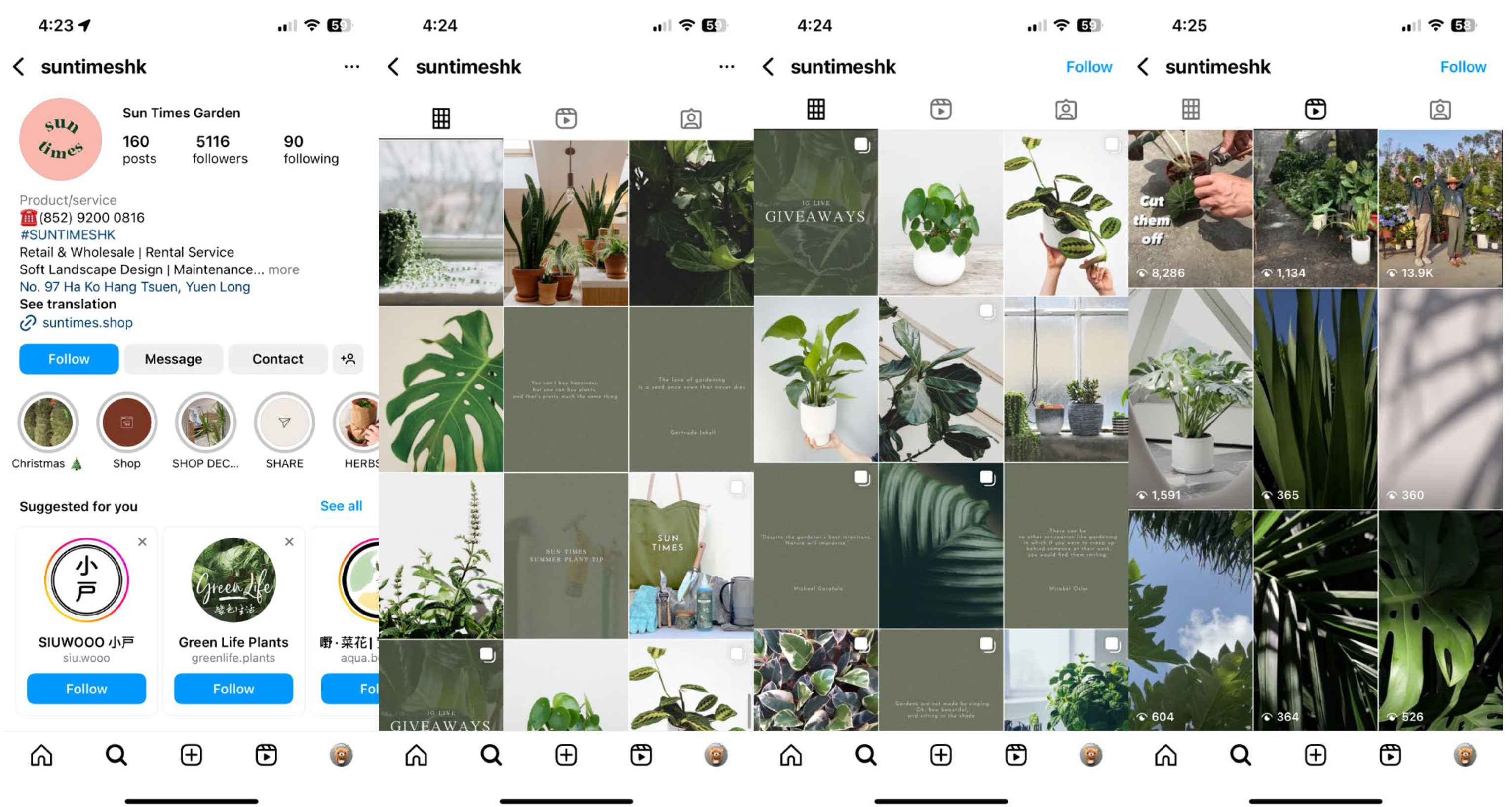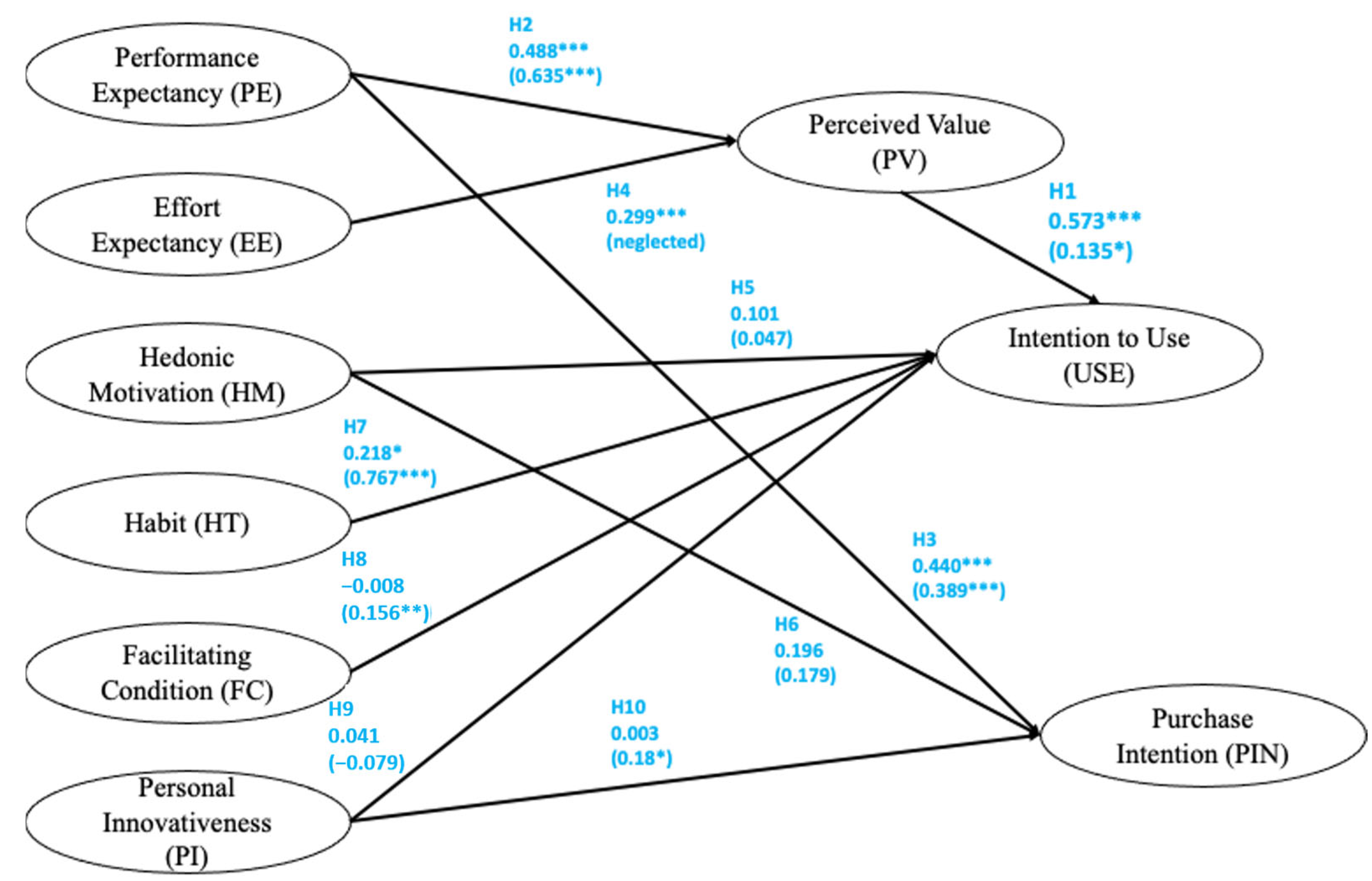Exploring Consumer Acceptance of Metaverse Marketing for Branding Activities and the Pre-Purchase Stage
Abstract
1. Introduction
2. Literature Review
2.1. Digital Marketing
2.2. Metaverse Marketing
2.3. Theoretical Framework
2.4. Hypothesis Development
| Hypothesis | Description | Literature Review |
|---|---|---|
| H1 | Perceived value positively influences consumers’ use intention of the technology. | Mooradian, Matzler [53] Ledden, Kalafatis [31] Huang, Wang [33] Sweeney and Soutar [30] Fatima, Kashif [32] |
| H2 | Performance expectancy positively influences consumers’ perceived value of the technology. | Venkatesh, Morris [54] Dhiman, Arora [34] Alalwan, Dwivedi [35] Miladinovic and Hong [36] |
| H3 | Performance expectancy positively influences consumers’ purchase intention. | Lin and Kim [37] Sharifi fard, Tamam [38] Alalwan [39] Shafnaz [40] Chen, Rashidin [41] |
| H4 | Effort expectancy positively influences consumers’ perceived value of the technology. | Venkatesh, Morris [54] Fatima, Kashif [32] Zhao and Bacao [42] |
| H5 | Hedonic motivation positively influences consumers’ use intention of the technology. | Eneizan, Mohammed [43] Dhiman, Arora [34] |
| H6 | Hedonic motivation positively influences consumers’ purchase intention. | Mustafi and Hosain [44] Alalwan [39] Shafnaz [40] |
| H7 | Habit positively influences consumers’ use intention of the technology. | Limayem, Hirt [45] Isa and Wong [46] Gansser and Reich [51] Tam, Santos [55] Megadewandanu [47] |
| H8 | Facilitating conditions positively influence consumers’ use intention of the technology. | Venkatesh, Morris [54] Nanayakkara [48] Alalwan, Dwivedi [49] Fatima, Kashif [32] |
| H9 | Personal innovativeness positively influences consumers’ use intention of the technology. | Dewi, Mohaidin [50] Gansser and Reich [51] An, Han [52] |
| H10 | Personal innovativeness positively influences consumers’ purchase intention. | Dewi, Mohaidin [50] |
3. Methodology
3.1. The Metaverse Space and Digital Marketing
3.2. Questionnaire Design and Measurements
3.3. Data Analysis
4. Results
4.1. Descriptive Statistics
4.2. Measurement Model
4.2.1. Normality Test
4.2.2. Exploratory Factor Analysis
4.2.3. Reliability and Validity
4.2.4. Model Fit Assessment
4.3. Structural Model
5. Discussion
6. Conclusions
Author Contributions
Funding
Institutional Review Board Statement
Informed Consent Statement
Data Availability Statement
Conflicts of Interest
References
- Bilgihan, A.; Leong, A.M.W.; Okumus, F.; Bai, J. Proposing a metaverse engagement model for brand development. J. Retail. Consum. Serv. 2024, 78, 103781. [Google Scholar] [CrossRef]
- Fan, Y.; Wong, I.A.; Zhang, G.; Lin, Z.; Wu, L. A multiwave study on tourist well-being: The role of attention restoration, psychological-need and social-sharing satisfaction. Tour. Manag. Perspect. 2024, 51, 101234. [Google Scholar] [CrossRef]
- Hughes, C.; Swaminathan, V.; Brooks, G. Driving brand engagement through online social influencers: An empirical investigation of sponsored blogging campaigns. J. Mark. 2019, 83, 78–96. [Google Scholar] [CrossRef]
- Pan, M.; Blut, M.; Ghiassaleh, A.; Lee, Z.W.Y. Influencer marketing effectiveness: A meta-analytic review. J. Acad. Mark. Sci. 2024, 53, 52–78. [Google Scholar] [CrossRef]
- Trachuk, T.; Vdovichena, O.; Andriushchenko, M.; Semenda, O.; Pashkevych, M. Branding and advertising on social networks: Current trends. Int. J. Comput. Sci. Netw. Secur. 2021, 21, 178–185. [Google Scholar]
- Joy, A.; Zhu, Y.; Peña, C.; Brouard, M. Digital future of luxury brands: Metaverse, digital fashion, and non-fungible tokens. Strateg. Change 2022, 31, 337–343. [Google Scholar] [CrossRef]
- Park, S.-M.; Kim, Y.-G. A metaverse: Taxonomy, components, applications, and open challenges. IEEE Access 2022, 10, 4209–4251. [Google Scholar] [CrossRef]
- Patil, K.; Pramod, D. Can Metaverse Retail lead to purchase intentions among the youth? A Stimulus-Organism-Response theory perspective. In Proceedings of the ASU International Conference in Emerging Technologies for Sustainability and Intelligent Systems (ICETSIS), Manama, Bahrain, 22–23 June 2022; pp. 314–320. [Google Scholar]
- Oh, H.J.; Kim, J.; Chang, J.J.; Park, N.; Lee, S. Social benefits of living in the metaverse: The relationships among social presence, supportive interaction, social self-efficacy, and feelings of loneliness. Comput. Hum. Behav. 2023, 139, 107498. [Google Scholar] [CrossRef]
- Dwivedi, Y.K.; Hughes, L.; Baabdullah, A.M.; Ribeiro-Navarrete, S.; Giannakis, M.; Al-Debei, M.M.; Dennehy, D.; Metri, B.; Buhalis, D.; Cheung, C.M. Metaverse beyond the hype: Multidisciplinary perspectives on emerging challenges, opportunities, and agenda for research, practice and policy. Int. J. Inf. Manag. 2022, 66, 102542. [Google Scholar] [CrossRef]
- Henz, P. The societal impact of the Metaverse. Discov. Artif. Intell. 2022, 2, 19. [Google Scholar] [CrossRef]
- McColl-Kennedy, J.R.; Gustafsson, A.; Jaakkola, E.; Klaus, P.; Radnor, Z.J.; Perks, H.; Friman, M. Fresh perspectives on customer experience. J. Serv. Mark. 2015, 29, 430–435. [Google Scholar] [CrossRef]
- Ma, D.; Zhang, C.; Hui, Y.; Xu, B. Economic uncertainty spillover and social networks. J. Bus. Res. 2022, 145, 454–467. [Google Scholar] [CrossRef]
- Syed, A.A.; Gaol, F.L.; Pradipto, Y.D.; Matsuo, T. Augmented and virtual reality in e-commerce—A survey. ICIC Express. Lett. 2021, 15, 1227–1233. [Google Scholar]
- Xi, N.; Hamari, J. Shopping in virtual reality: A literature review and future agenda. J. Bus. Res. 2021, 134, 37–58. [Google Scholar] [CrossRef]
- Tang, Y.M.; Lau, Y.-y.; Ho, U.L. Empowering Digital Marketing with Interactive Virtual Reality (IVR) in Interior Design: Effects on Customer Satisfaction and Behaviour Intention. J. Theor. Appl. Electron. Commer. Res. 2023, 18, 889–907. [Google Scholar] [CrossRef]
- Tayal, S.; Rajagopal, K.; Mahajan, V. Virtual reality based metaverse of gamification. In Proceedings of the 2022 6th International Conference on Computing Methodologies and Communication (ICCMC), Erode, India, 29–31 March 2022; pp. 1597–1604. [Google Scholar]
- Lee, S.; Oh, Y. Study on Virtual Reality and E-commerce. Int. J. Adv. Cult. Technol. 2016, 4, 70–74. [Google Scholar] [CrossRef]
- Rauschnabel, P.A.; Felix, R.; Hinsch, C. Augmented reality marketing: How mobile AR-apps can improve brands through inspiration. J. Retail. Consum. Serv. 2019, 49, 43–53. [Google Scholar] [CrossRef]
- Chan, Y.K.; Tang, Y.M.; Teng, L. A comparative analysis of digital health usage intentions towards the adoption of virtual reality in telerehabilitation. Int. J. Med. Inform. 2023, 174, 105042. [Google Scholar] [CrossRef]
- Cheung, V.Y.; Tang, Y.M.; Chan, K.K. Medical students’ perception of the application of a virtual reality training model to acquire vaginal examination skills. Int. J. Gynecol. Obstet. 2023, 161, 827–832. [Google Scholar] [CrossRef]
- Tang, Y.M.; Kuo, W.T.; Lee, C. Real-time Mixed Reality (MR) and Artificial Intelligence (AI) object recognition integration for digital twin in Industry 4.0. Internet Things 2023, 23, 100753. [Google Scholar] [CrossRef]
- Xie, J.; Ye, L.; Huang, W.; Ye, M. Understanding FinTech Platform Adoption: Impacts of Perceived Value and Perceived Risk. J. Theor. Appl. Electron. Commer. Res. 2021, 16, 1893–1911. [Google Scholar] [CrossRef]
- Virtanen, H.; Björk, P.; Sjöström, E. Follow for follow: Marketing of a start-up company on Instagram. J. Small Bus. Enterp. Dev. 2017, 24, 468–484. [Google Scholar] [CrossRef]
- Khatri, M. Revamping the marketing world with metaverse—The future of marketing. Int. J. Comput. Appl. 2022, 975, 8887. [Google Scholar] [CrossRef]
- Hollensen, S.; Kotler, P.; Opresnik, M.O. Metaverse—The new marketing universe. J. Bus. Strategy 2022, 44, 119–125. [Google Scholar] [CrossRef]
- Van Kerrebroeck, H.; Brengman, M.; Willems, K. When brands come to life: Experimental research on the vividness effect of Virtual Reality in transformational marketing communications. Virtual Real. 2017, 21, 177–191. [Google Scholar] [CrossRef]
- Kim, J. Advertising in the metaverse: Research agenda. J. Interact. Advert. 2021, 21, 141–144. [Google Scholar] [CrossRef]
- Venkatesh, V.; Thong, J.Y.; Xu, X. Consumer acceptance and use of information technology: Extending the unified theory of acceptance and use of technology. MIS Q. 2012, 36, 157–178. [Google Scholar] [CrossRef]
- Sweeney, J.C.; Soutar, G.N. Consumer perceived value: The development of a multiple item scale. J. Retail. 2001, 77, 203–220. [Google Scholar] [CrossRef]
- Ledden, L.; Kalafatis, S.P.; Samouel, P. The relationship between personal values and perceived value of education. J. Bus. Res. 2007, 60, 965–974. [Google Scholar] [CrossRef]
- Fatima, T.; Kashif, S.; Kamran, M.; Awan, T.M. Examining factors influencing adoption of m-payment: Extending UTAUT2 with perceived value. Int. J. Innov. Creat. Change 2021, 15, 276–299. [Google Scholar]
- Huang, N.; Wang, L.; Hong, Y.; Lin, L.; Guo, X.; Chen, G. When the Clock Strikes: A Multimethod Investigation of On-the-Hour Effects in Online Learning. Inf. Syst. Res. 2024, 35, 766–782. [Google Scholar] [CrossRef]
- Dhiman, N.; Arora, N.; Dogra, N.; Gupta, A. Consumer adoption of smartphone fitness apps: An extended UTAUT2 perspective. J. Indian Bus. Res. 2020, 12, 363–388. [Google Scholar] [CrossRef]
- Alalwan, A.A.; Dwivedi, Y.K.; Rana, N.P.; Williams, M.D. Consumer adoption of mobile banking in Jordan: Examining the role of usefulness, ease of use, perceived risk and self-efficacy. J. Enterp. Inf. Manag. 2016, 29, 118–139. [Google Scholar] [CrossRef]
- Miladinovic, J.; Hong, X. A Study on Factors Affecting the Behavioral Intention to Use Mobile Shopping Fashion Apps in Sweden; Jönköping University: Jönköping, Sweden, 2016. [Google Scholar]
- Lin, C.A.; Kim, T. Predicting user response to sponsored advertising on social media via the technology acceptance model. Comput. Hum. Behav. 2016, 64, 710–718. [Google Scholar] [CrossRef]
- Fard, S.S.; Tamam, E.; Hj Hassan, M.S.; Waheed, M.; Zaremohzzabieh, Z. Factors affecting Malaysian university students’ purchase intention in social networking sites. Cogent Bus. Manag. 2016, 3, 1182612. [Google Scholar] [CrossRef]
- Alalwan, A.A. Investigating the impact of social media advertising features on customer purchase intention. Int. J. Inf. Manag. 2018, 42, 65–77. [Google Scholar] [CrossRef]
- Shafnaz, S. Factors Influencing Customer Purchase Intention: Reference to Social Media Advertising. Wayamba J. Manag. 2021, 12, 350–372. [Google Scholar] [CrossRef]
- Chen, L.; Rashidin, M.S.; Song, F.; Wang, Y.; Javed, S.; Wang, J. Determinants of consumer’s purchase intention on fresh e-commerce platform: Perspective of UTAUT model. Sage Open 2021, 11, 21582440211027875. [Google Scholar] [CrossRef]
- Zhao, Y.; Bacao, F. Theoretical development: Extending the flow theory with variables from the utaut2 model. In Proceedings of the 2020 IEEE 6th International Conference on Computer and Communications (ICCC), Chengdu, China, 11–14 December 2020; pp. 2427–2431. [Google Scholar]
- Eneizan, B.; Mohammed, A.G.; Alnoor, A.; Alabboodi, A.S.; Enaizan, O. Customer acceptance of mobile marketing in Jordan: An extended UTAUT2 model with trust and risk factors. Int. J. Eng. Bus. Manag. 2019, 11, 1847979019889484. [Google Scholar] [CrossRef]
- Mustafi, M.A.A.; Hosain, M.S. The role of online advertising on purchase intention of smartphones: Mediating effects of flow experience and advertising value. J. Contemp. Mark. Sci. 2020, 3, 385–410. [Google Scholar] [CrossRef]
- Limayem, M.; Hirt, S.G.; Cheung, C.M. How habit limits the predictive power of intention: The case of information systems continuance. MIS Q. 2007, 31, 705–737. [Google Scholar] [CrossRef]
- Isa, S.M.; Wong, K.-Y. Age differences in behavioral intention to use internet marketing: A comparative study between Malaysian and Taiwanese. Int. J. Bus. Soc. 2015, 16, 386–396. [Google Scholar]
- Megadewandanu, S. Exploring mobile wallet adoption in Indonesia using UTAUT2: An approach from consumer perspective. In Proceedings of the 2nd International Conference on Science and Technology-Computer (ICST), Yogyakarta, Indonesia, 27–28 October 2016; pp. 11–16. [Google Scholar]
- Nanayakkara, C. A model of user acceptance of learning management systems: A study within tertiary institutions in New Zealand. Int. J. Learn. 2007, 13, 223–232. [Google Scholar]
- Alalwan, A.A.; Dwivedi, Y.K.; Rana, N.P. Factors influencing adoption of mobile banking by Jordanian bank customers: Extending UTAUT2 with trust. Int. J. Inf. Manag. 2017, 37, 99–110. [Google Scholar] [CrossRef]
- Dewi, C.K.; Mohaidin, Z.; Murshid, M.A. Determinants of online purchase intention: A PLS-SEM approach: Evidence from Indonesia. J. Asia Bus. Stud. 2020, 14, 281–306. [Google Scholar] [CrossRef]
- Gansser, O.A.; Reich, C.S. A new acceptance model for artificial intelligence with extensions to UTAUT2: An empirical study in three segments of application. Technol. Soc. 2021, 65, 101535. [Google Scholar] [CrossRef]
- An, L.; Han, Y.; Tong, L. Study on the factors of online shopping intention for fresh agricultural products based on UTAUT2. In Proceedings of the The 2nd Information Technology and Mechatronics Engineering Conference (ITOEC 2016), Chongqing, China, 21–22 May 2016; pp. 303–306. [Google Scholar]
- Mooradian, T.; Matzler, K.; Strobl, A.; Teichmann, K. Tell me where you come from and I know what makes you tick: Managing the consumer personality–satisfaction link in diverse cultures. J. Consum. Behav. 2023, 22, 253–271. [Google Scholar] [CrossRef]
- Venkatesh, V.; Morris, M.G.; Davis, G.B.; Davis, F.D. User acceptance of information technology: Toward a unified view. MIS Q. 2003, 27, 425–478. [Google Scholar] [CrossRef]
- Tam, C.; Santos, D.; Oliveira, T. Exploring the influential factors of continuance intention to use mobile Apps: Extending the expectation confirmation model. Inf. Syst. Front. 2020, 22, 243–257. [Google Scholar] [CrossRef]
- Shin, S.; Lee, W.-J. Factors affecting user acceptance for NFC mobile wallets in the US and Korea. Innov. Manag. Rev. 2021, 18, 417–433. [Google Scholar] [CrossRef]
- Yu, C.-W.; Chao, C.-M.; Chang, C.-F.; Chen, R.-J.; Chen, P.-C.; Liu, Y.-X. Exploring behavioral intention to use a mobile health education website: An extension of the utaut 2 model. Sage Open 2021, 11, 21582440211055721. [Google Scholar] [CrossRef]
- Nguyen, T.T.; Nguyen, H.T.; Mai, H.T.; Tran, T.T.M. Determinants of digital banking services in Vietnam: Applying utaut2 model. Asian Econ. Financ. Rev. 2020, 10, 680. [Google Scholar] [CrossRef]
- Rudhumbu, N. Applying the UTAUT2 to predict the acceptance of blended learning by university students. Asian Assoc. Open Univ. J. 2022, 17, 15–36. [Google Scholar] [CrossRef]
- Tak, P.; Panwar, S. Using UTAUT 2 model to predict mobile app based shopping: Evidences from India. J. Indian Bus. Res. 2017, 9, 248–264. [Google Scholar] [CrossRef]
- Gharaibeh, N.; Gharaibeh, M.K.; Gharaibeh, O.; Bdour, W. Exploring intention to adopt mobile commerce: Integrating UTAUT2 with social media. Int. J. Sci. Technol. Res. 2020, 9, 3826–3833. [Google Scholar]
- Singh, M.; Matsui, Y. How long tail and trust affect online shopping behavior: An extension to UTAUT2 framework. Pac. Asia J. Assoc. Inf. Syst. 2017, 9, 2. [Google Scholar] [CrossRef]
- Paulo, M.M.; Rita, P.; Oliveira, T.; Moro, S. Understanding mobile augmented reality adoption in a consumer context. J. Hosp. Tour. Technol. 2018, 9, 142–157. [Google Scholar] [CrossRef]
- Park, S.; Kim, E.Y. A longitudinal study for predicting intentions to use augmented reality technology in the fashion shopping context. Int. J. Costume Fash. 2021, 21, 1–13. [Google Scholar] [CrossRef]
- Kourouthanassis, P.; Boletsis, C.; Bardaki, C.; Chasanidou, D. Tourists responses to mobile augmented reality travel guides: The role of emotions on adoption behavior. Pervasive Mob. Comput. 2015, 18, 71–87. [Google Scholar] [CrossRef]
- Liu, F.; Zhao, X.; Chau, P.Y.; Tang, Q. Roles of perceived value and individual differences in the acceptance of mobile coupon applications. Internet Res. 2015, 25, 471–495. [Google Scholar] [CrossRef]
- Shaw, N.; Sergueeva, K. The non-monetary benefits of mobile commerce: Extending UTAUT2 with perceived value. Int. J. Inf. Manag. 2019, 45, 44–55. [Google Scholar] [CrossRef]
- Sitar-Taut, D.-A.; Mican, D. Mobile learning acceptance and use in higher education during social distancing circumstances: An expansion and customization of UTAUT2. Online Inf. Rev. 2021, 45, 1000–1019. [Google Scholar] [CrossRef]
- Duffett, R.G. Facebook advertising’s influence on intention-to-purchase and purchase amongst Millennials. Internet Res. 2015, 25, 498–526. [Google Scholar] [CrossRef]
- Kline, R.B. Principles and Practice of Structural Equation Modeling; Guilford: New York, NY, USA, 2023. [Google Scholar]
- Saxena, M.; Bagga, T.; Gupta, S.; Kaushik, N. Exploring common method variance in analytics research in the Indian context: A comparative study with known techniques. FIIB Bus. Rev. 2022, 13, 23197145221099098. [Google Scholar] [CrossRef]
- Podsakoff, P.M.; MacKenzie, S.B.; Lee, J.-Y.; Podsakoff, N.P. Common method biases in behavioral research: A critical review of the literature and recommended remedies. J. Appl. Psychol. 2003, 88, 879–903. [Google Scholar] [CrossRef]
- Kock, N.; Lynn, G. Lateral Collinearity and Misleading Results in Variance-Based SEM: An Illustration and Recommendations. J. Assoc. Inf. Syst. 2012, 13, 546–580. [Google Scholar] [CrossRef]
- Alibo, D.; Amakawa, H.; Nozaki, Y. Determination of indium in natural waters by flow injection inductively coupled plasma mass spectrometry. Proc. Indian Acad. Sci. Earth Planet. Sci. 1998, 107, 359–366. [Google Scholar] [CrossRef]
- Garg, A. Investigating the moderating effects of age and gender on customers’ use of tablet menu in casual dining restaurants. J. Qual. Assur. Hosp. Tour. 2022, 23, 1509–1547. [Google Scholar] [CrossRef]
- Kaiser, H.F. An index of factorial simplicity. Psychometrika 1974, 39, 31–36. [Google Scholar] [CrossRef]
- Pett, M.A.; Lackey, N.R.; Sullivan, J.J. Making Sense Of Factor Analysis: The Use of Factor Analysis for Instrument Development in Health Care Research; Sage: Thousand Oaks, CA, USA, 2003. [Google Scholar]
- Mathur, S.K.; Dhulla, T.V. Factors influencing professionals’ decision for cloud computing adoption. Int. J. Res. Advent Technol. 2014, 2, 397–401. [Google Scholar]
- Van Truong, H.; Pham, C.H.; Vo, N.H. Service quality and students level of satisfaction in private colleges in Vietnam. Int. J. Financ. Res. 2016, 7, 121–128. [Google Scholar] [CrossRef]
- Heale, R.; Twycross, A. Validity and reliability in quantitative studies. Evid.-Based Nurs. 2015, 18, 66–67. [Google Scholar] [CrossRef] [PubMed]
- Santos, J.R.A. Cronbach’s alpha: A tool for assessing the reliability of scales. J. Ext. 1999, 37, 1. [Google Scholar]
- Taber, K.S. The Use of Cronbach’s Alpha When Developing and Reporting Research Instruments in Science Education. Res. Sci. Educ. 2018, 48, 1273–1296. [Google Scholar] [CrossRef]
- Hair, J.F.; Black, W.C.; Babin, B.J. Multivariate Data Analysis: A Global Perspective; Pearson Education: London, UK, 2010. [Google Scholar]
- Gala, P.; Kashmiri, S. Exploring the dark side of integrity: Impact of CEO integrity on firms’ innovativeness, risk-taking and proactiveness. Eur. J. Mark. 2022, 56, 2052–2102. [Google Scholar] [CrossRef]
- Kennedy, A.; Nelson, E.; Reeves, D.; Richardson, G.; Roberts, C.; Robinson, A.; Rogers, A.; Sculpher, M.; Thompson, D. A randomised controlled trial to assess the impact of a package comprising a patient-orientated, evidence-based self-help guidebook and patient-centred consultations on disease management and satisfaction in inflammatory bowel disease. Health Technol. Assess. 2003, 7, 1–113. [Google Scholar] [CrossRef]
- Marsh, H.W.; Kit-Tai, H.; and Wen, Z. In Search of Golden Rules: Comment on Hypothesis-Testing Approaches to Setting Cutoff Values for Fit Indexes and Dangers in Overgeneralizing Hu and Bentler’s (1999) Findings. Struct. Equ. Model. Multidiscip. J. 2004, 11, 320–341. [Google Scholar] [CrossRef]
- Hu, L.T.; Bentler, P.M. Cutoff criteria for fit indexes in covariance structure analysis: Conventional criteria versus new alternatives. Struct. Equ. Model. Multidiscip. J. 1999, 6, 1–55. [Google Scholar] [CrossRef]
- Goren, A.; Harris, J.L.; Schwartz, M.B.; Brownell, K.D. Predicting support for restricting food marketing to youth. Health Aff. 2010, 29, 419–424. [Google Scholar] [CrossRef]
- Haba, H.; Hassan, Z.; Dastane, D.O. Factors leading to consumer perceived value of smartphones and its impact on purchase intention. Glob. Bus. Manag. Res. Int. J. 2017, 9, 42–71. [Google Scholar][Green Version]
- Jakkaew, P.; Hemrungrote, S. The use of UTAUT2 model for understanding student perceptions using Google classroom: A case study of introduction to information technology course. In Proceedings of the International Conference on Digital Arts, Media and Technology (ICDAMT), Chiang Mai, Thailand, 1–4 March 2017; pp. 205–209. [Google Scholar]
- Ain, N.; Kaur, K.; Waheed, M. The influence of learning value on learning management system use: An extension of UTAUT2. Inf. Dev. 2016, 32, 1306–1321. [Google Scholar] [CrossRef]
- Raza, S.A.; Shah, N.; Ali, M. Acceptance of mobile banking in Islamic banks: Evidence from modified UTAUT model. J. Islam. Mark. 2019, 10, 357–376. [Google Scholar] [CrossRef]
- Korn, O.; Zallio, M.; Schnitzer, B. Young skeptics: Exploring the perceptions of virtual worlds and the metaverse in generations Y and Z. Front. Virtual Real. 2024, 5. [Google Scholar] [CrossRef]
- Ma, J.; Wang, P.; Li, B.; Wang, T.; Pang, S.; Wang, D. Exploring User Adoption of ChatGPT: A Technology Acceptance Model Perspective. Int. J. Hum.-Comput. Interact. 2024, 41, 1431–1445. [Google Scholar] [CrossRef]



| Exterior design |  |  |
| Entrance |  |  |
| Products and descriptions |  |  |
 |  | |
| Other facilities |  |  |
 |  |
| Construct | References |
|---|---|
| Performance Expectancy (PE) | Venkatesh, Thong [29] Tam, Santos [55] Shin and Lee [56] |
| Effort Expectancy (EE) | Venkatesh, Thong [29] Yu, Chao [57] Nguyen, Nguyen [58] Rudhumbu [59] |
| Hedonic Motivation (HM) | Venkatesh, Thong [29] Tak and Panwar [60] Gharaibeh, Gharaibeh [61] Alalwan [39] |
| Habit (HT) | Venkatesh, Thong [29] Tak and Panwar [60] Singh and Matsui [62] |
| Facilitating Conditions (FC) | Venkatesh, Thong [29] Paulo, Rita [63] Park and Kim [64] |
| Personal Innovativeness (PI) | Gansser and Reich [51] Kourouthanassis, Boletsis [65] |
| Perceived Value (PV) | Liu, Zhao [66] Shaw and Sergueeva [67] |
| Intention to Use (USE) | Sitar-Taut and Mican [68] Shaw and Sergueeva [67] |
| Purchase Intention (PIN) | Alalwan [39] Duffett [69] |
| Variable | Overall (n) | Metaverse Group (n) | Social Media Group (n) |
|---|---|---|---|
| Age | |||
| 18–24 years | 106 (53.8%) | 40 (44.9%) | 66 (61.1%) |
| 25–34 years | 29 (14.72%) | 17 (19.1%) | 12 (11.1%) |
| 35–44 years | 17 (8.63%) | 13 (14.6%) | 4 (3.7%) |
| 45–54 years | 28 (14.21%) | 8 (9%) | 20 (18.5%) |
| 55–64 years | 17 (8.63%) | 11 (12.4%) | 6 (5.56%) |
| Total | 197 (100%) | 89 (100%) | 108 (100%) |
| Gender | |||
| Male | 77 (39.09%) | 45 (50.6%) | 32 (29.6%) |
| Female | 120 (60.91%) | 44 (49.4%) | 76 (70.4%) |
| Total | 197 (100%) | 89 (100%) | 108 (100%) |
| Mean | SD | VIF | Skewness | Kurtosis | |||
|---|---|---|---|---|---|---|---|
| Statistic | Std. Error | Statistic | Std. Error | ||||
| PE | 3.393 (3.618) | 0.785 (0.795) | 1.535 (1.560) | 0.020 (−0.841) | 0.255 (0.233) | −0.824 (1.368) | 0.506 (0.461) |
| EE | 3.715 (4.269) | 0.799 (0.638) | 1.535 (1.560) | −0.1 (−1.087) | 0.255 (0.233) | −0.82 (1.854) | 0.506 (0.461) |
| HM | 3.757 (4.025) | 0.866 (0.874) | 1.781 (1.569) | −0.212 (−0.78) | 0.255 (0.233) | −0.589 (−0.134) | 0.506 (0.461) |
| HT | 2.596 (2.833) | 1.137 (1.093) | 1.360 (1.987) | 0230 (0.189) | 0.255 (0.233) | −0.0968 (−0.89) | 0.506 (0.461) |
| FC | 3.467 (4.065) | 0.825 (0.66) | 1.975 (1.915) | −0.146 (−0.998) | 0.255 (0.233) | −0.947 (1.758) | 0.506 (0.461) |
| PI | 3.626 (3.577) | 0.712 (0.83) | 1.889 (1.518) | −0.529 (−0.431) | 0.255 (0.233) | −0.013 (−0.016) | 0.506 (0.461) |
| PV | 3.64 (3.875) | 0.897 (0.691) | 1.562 (3.226) | −0.63 (−0.621) | 0.255 (0.233) | −0.111 (1.303) | 0.506 (0.461) |
| USE | 3.191 (3.296) | 1.102 (1.006) | 1.975 (3.226) | −0.204 (−0.033) | 0.255 (0.233) | −0.757 (−0.799) | 0.506 (0.461) |
| PIN | 3.188 (3.051) | 0.914 (0.986) | 1.548 (1.457) | −0.507 (0.362) | 0.255 (0.233) | −0.051 (−0.589) | 0.506 (0.461) |
| KMO and Bartlett’s Test | ||||
|---|---|---|---|---|
| Kaiser-Meyer-Olkin Measure of Sampling Adequacy. | 0.758 | |||
| (0.849) | ||||
| Bartlett’s Test of Sphericity | Approx. Chi-Square | 3826.112 | ||
| (3639.87) | ||||
| df | 528 | |||
| (528) | ||||
| Sig. | 0 | |||
| (0) | ||||
| Reliability and Validity Statistics | |||
|---|---|---|---|
| Cronbach’s Alpha | CR | AVE | |
| Overall | 0.952 | ||
| PE | (0.951) 0.832 | 0.841 (0.894) | 0.727 (0.679) |
| EE | (0.889) 0.848 | 0.873 (-) | 0.696 (-) |
| HM | (-) 0.910 | 0.923 (0.924) | 0.8 (0.802) |
| HT | (0.921) 0.959 | 0.961 (0.927) | 0.861 (0.761) |
| FC | (0.923) 0.787 | 0.805 (0.798) | 0.598 (0.59) |
| PI | (0.714) 0.828 | 0.832 (0.874) | 0.626 (0.7) |
| PV | (0.872) 0.943 | 0.947 (0.739) | 0.817 (0.592) |
| USE | (0.71) 0.921 | 0.924 (0.929) | 0.801 (0.813) |
| PIN | (0.927) 0.951 (0.927) | 0.952 (0.927) | 0.834 (0.761) |
| EE | FC | HM | HT | PE | PI | PIN | PV | USE | |
|---|---|---|---|---|---|---|---|---|---|
| EE | 0.851 (0.871) | ||||||||
| FC | 0.569 (0.613) | 0.777 (0.800) | |||||||
| HM | 0.623 (0.576) | 0.481 (0.300) | 0.927 (0.930) | ||||||
| HT | 0.297 (0.271) | 0.401 (0.183) | 0.425 (0.424) | 0.945 (0.902) | |||||
| PE | 0.590 (0.552) | 0.508 (0.377) | 0.441 (0.481) | 0.303 (0.523) | 0.809 (0.868) | ||||
| PI | 0.536 (0.474) | 0.611 (0.501) | 0.543 (0.321) | 0.213 (0.399) | 0.401 (0.288) | 0.859 (0.893) | |||
| PIN | 0.381 (0.351) | 0.507 (0.424) | 0.386 (0.431) | 0.330 (0.788) | 0.642 (0.542) | 0.317 (0.355) | 0.934 (0.906) | ||
| PV | 0.527 (0.606) | 0.516 (0.574) | 0.498 (0.576) | 0.367 (0.639) | 0.698 (0.652) | 0.423 (0.475) | 0.754 (0.657) | 0.928 (0.861) | |
| USE | 0.462 (0.389) | 0.455 (0.328) | 0.494 (0.455) | 0.486 (0.867) | 0.704 (0.636) | 0.394 (0.381) | 0.791 (0.803) | 0.715 (0.717) | 0.931 (0.935) |
| Model Type | χ2/df | CFI | TLI | RMSEA |
|---|---|---|---|---|
| Measurement Model | 1.24 (1.38) | 0.89 (0.89) | 0.88 (0.88) | 0.051 (0.045) |
| Structural Model | 1.20 (1.37) | 0.88 (0.87) | 0.87 (0.86) | 0.052 (0.047) |
| Threshold | <3 [85] | ≥0.85 [86] | ≥0.85 [86] | ≤0.06 [87] |
| Hypothesis | Regression Path | Path Coefficient (β) | Std Errors | Effect Size | CI 95% | t-Value | p-Value |
|---|---|---|---|---|---|---|---|
| H1 | PV → USE | 0.573 (0.135) | 0.085 (0.08) | 0.489 0.489 | [0.397, 0.733] [0.053, 0.370] | 6.602 (1.993) | <0.001 (0.049) |
| H2 | PE → PV | 0.488 (0.635) | 0.073 (0.08) | 0.167 0.167 | [0.457, 0.744] [0.303, 0.629] | 5.626 (8.468) | <0.001 (<0.001) |
| H3 | PE → PIN | 0.440 (0.389) | 0.095 (0.071) | 0.457 0.457 | [0.380, 0.749] [0.237, 0.527] | 4.368 (4.255) | <0.001 (<0.001) |
| H4 | EE → PV | 0.299 (-) | 0.100 (0.09) | 0.041 0.041 | [−0.031, 0.361] [0.187, 0.525] | 3.443 (-) | <0.001 (-) |
| H5 | HM →USE | 0.101 (0.047) | 0.078 (0.053) | 0.029 0.029 | [−0.075, 0.232] [−0.089, 0.116] | 1.066 (0.880) | 0.290 (0.381) |
| H6 | HM → PIN | 0.196 (0.179) | 0.107 (0.081) | 0.041 0.016 | [−0.087, 0.324] [−0.001. 0.332] | 1.746 (1.940) | 0.084 (0.055) |
| H7 | HT → USE | 0.218 (0.767) | 0.090 (0.053) | 0.098 0.098 | [0.058, 0.414] [0.612, 0.841] | 2.593 (12.657) | 0.011 (<0.001) |
| H8 | FC → USE | −0.008 (0.156) | 0.112 (0.072) | 0.000 0.000 | [−0.236, 0.209] [−0.018, 0.247] | −0.074 (2.733) | 0.941 (0.007) |
| H9 | PI → USE | 0.041 (−0.079) | 0.089 (0.06) | 0.009 0.000 | [−0.087, 0.261] [−0.19, 0.042] | 0.385 (−1.395) | 0.701 (0.166) |
| H10 | PI→ PIN | 0.003 (0.18) | 0.091 (0.076) | 0.000 | [−0.087, 0.261] [0.03. 0.335] | 0.026 (2.124) | 0.980 (0.036) |
| Levene’s Test | t-Test | |||||
|---|---|---|---|---|---|---|
| F | Sig. | t | df | Significance Two-Sided p | ||
| PE | Equal variances assumed | 0.075 (16.059) | 0.784 (0) | 0.456 (2.305) | 87 (106) | 0.649 (0.023) |
| Equal variances not assumed | 0.456 (1.85) | 86.987 (39.397) | 0.649 (0.072) | |||
| EE | Equal variances assumed | 0.007 (-) | 0.933 (-) | 0.491 (-) | 87 (-) | 0.625 (-) |
| Equal variances not assumed | 0.491 (-) | 87 (-) | 0.625 (-) | |||
| HM | Equal variances assumed | 4.724 (5.174) | 0.032 (0.025) | 0.58 (0.03) | 87 (106) | 0.563 (0.976) |
| Equal variances not assumed | 0.579 (0.028) | 84.278 (50.07) | 0.564 (0.978) | |||
| HT | Equal variances assumed | 12.216 (1.932) | 0.001 (0.167) | −1.111 (1.487) | 87 (106) | 0.27 (0.14) |
| Equal variances not assumed | −1.116 (1.375) | 78.592 (49.67) | 0.268 (0.175) | |||
| FC | Equal variances assumed | 3.962 (5.1) | 0.05 (0.026) | −1.963 (−2.834) | 87 (106) | 0.053 (0.006) |
| Equal variances not assumed | −1.969 (−2.489) | 82.326 (45.234) | 0.052 (0.017) | |||
| PI | Equal variances assumed | 0.471 (1.212) | 0.494 (0.273) | −2.401 (−0.556) | 87 (106) | 0.018 (0.579) |
| Equal variances not assumed | −2.407 (−0.521) | 83.557 (50.888) | 0.018 (0.605) | |||
| PV | Equal variances assumed | 0.637 (3.876) | 0.427 (0.052) | 0.134 (−0.152) | 87 (106) | 0.894 (0.88) |
| Equal variances not assumed | 0.134 (−0.136) | 85.096 (46.675) | 0.894 (0.893) | |||
| USE | Equal variances assumed | 7.982 (6.959) | 0.006 (0.01) | 1.143 (2.162) | 87 (106) | 0.256 (0.033) |
| Equal variances not assumed | 1.147 (1.872) | 79.477 (44.171) | 0.255 (0.068) | |||
| PIN | Equal variances assumed | 2.559 (3.181) | 0.113 (0.077) | 1.273 (−0.238) | 87 (106) | 0.206 (0.812) |
| Equal variances not assumed | 1.277 (−0.217) | 82.659 (48.413) | 0.205 (0.829) | |||
Disclaimer/Publisher’s Note: The statements, opinions and data contained in all publications are solely those of the individual author(s) and contributor(s) and not of MDPI and/or the editor(s). MDPI and/or the editor(s) disclaim responsibility for any injury to people or property resulting from any ideas, methods, instructions or products referred to in the content. |
© 2025 by the authors. Licensee MDPI, Basel, Switzerland. This article is an open access article distributed under the terms and conditions of the Creative Commons Attribution (CC BY) license (https://creativecommons.org/licenses/by/4.0/).
Share and Cite
Tang, Y.M.; Wong, J.K.N.; Ho, G.T.S. Exploring Consumer Acceptance of Metaverse Marketing for Branding Activities and the Pre-Purchase Stage. J. Theor. Appl. Electron. Commer. Res. 2025, 20, 159. https://doi.org/10.3390/jtaer20030159
Tang YM, Wong JKN, Ho GTS. Exploring Consumer Acceptance of Metaverse Marketing for Branding Activities and the Pre-Purchase Stage. Journal of Theoretical and Applied Electronic Commerce Research. 2025; 20(3):159. https://doi.org/10.3390/jtaer20030159
Chicago/Turabian StyleTang, Yuk Ming, Jessie Kwan Ning Wong, and G. T. S. Ho. 2025. "Exploring Consumer Acceptance of Metaverse Marketing for Branding Activities and the Pre-Purchase Stage" Journal of Theoretical and Applied Electronic Commerce Research 20, no. 3: 159. https://doi.org/10.3390/jtaer20030159
APA StyleTang, Y. M., Wong, J. K. N., & Ho, G. T. S. (2025). Exploring Consumer Acceptance of Metaverse Marketing for Branding Activities and the Pre-Purchase Stage. Journal of Theoretical and Applied Electronic Commerce Research, 20(3), 159. https://doi.org/10.3390/jtaer20030159








